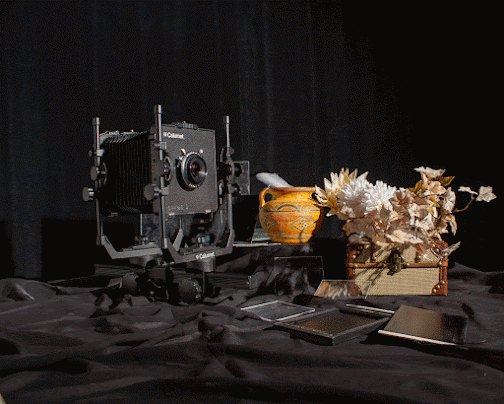The overall concept was to have the viewer question how the photo was taken. To show the opposite of this assignment, to reveal the new as the old. To have the two different cameras in one photo, but to also highlight the 4x5 camera’s equipment such as metal plates, glass, and the holders for the plates. And the irony of having the 4 x 5 camera and myself with a digital camera in the background in a mirror, reflecting back. Some elements from the Library of Congress are the crack in the upper right corner, the frame around the whole image, and the two edges that add texture under the frame around the corners. In total, I used four different images from the Library of Congress.


In the Old Is New Again project by Dominique Rodriguez the subject is a still life set up of a large format view camera, film holders, and glass plates. A keepsake box, flowers, and a feather in a pot are also included. What is perhaps more hidden, however, is an image of the photographer taking the photo from in between the body and rail of the view camera using a Canon camera. The overall tone of the image is a lightly saturated sepia over black and white with lots of light colored blemishes around the bottom left corner. There is also a crack in the upper right corner, as well as some stray blemishes/fogging. The image is bordered by a golden ornate frame.
ReplyDeleteBased on the above description and my own experience, my interpretation of this artwork is that it’s a statement on the implied disconnect of older and more “outdated” forms of photography, such as large format which is the highlighted subject of this work. The set up of the props being similar to a still life also adds to that antiquity and old feeling. However, the artist counteracts this by inserting herself into the image by posing as if taking a photo using a modern DSLR camera. Instead of just leaving the takeaway from this work being that historic photographic techniques are useless or unnecessary, we, the viewer, see that it’s more of a reciprocal relationship where both the old and new interact.
The application of the technical and more conceptual aspects is mostly solid. I find that the use of the photo crack, chemistry blemishes, and implied light leaks are quite successful in suggesting the wet plate collodion technique. I also really enjoy the use of the gaudy frame as a border as that was typical of the time. However, I am less excited about the placement of the photographer and DSLR camera. I already knew that this element was going to be a part of the image, even before the still life was shot, but I’m not sure I would have noticed the peek a boo person if I didn’t know to look. I think the concept here is strong, but would be better implemented if the photographer instead appeared on a piece of mirror set up in the still life, or even as a negative on the glass. A small, picky thing about this too is that the camera brand, Canon, is backwards because it was taken through a mirror, however, then the rest of the image should also be flipped because the implication is that this whole image was shot by a way of mirror. That is really my only big critique of this piece.
While there is one issue, teetering on being a major problem, the overall cohesiveness and execution of this concept/assignment is skillful and thoughtful.